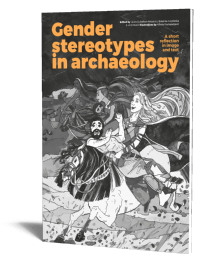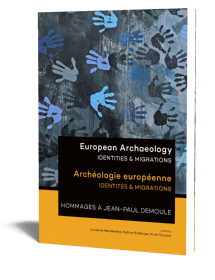Migration Narratives in Archaeology
Edited by Daniela Hofmann, Catherine J. Frieman & Astrid J. Nyland | 2023

Migration Narratives in Archaeology
Edited by Daniela Hofmann, Catherine J. Frieman & Astrid J. Nyland | 2023
Paperback ISBN: 9789464262025 | Imprint: Sidestone Press | Format: 200x270mm | 72 pp. | Series: HotAcademia | Language: English | 27 illus. (bw) | Keywords: archaeology; prehistory; migration; mobility; methods; stereotypes; stories | download cover | DOI: 10.59641/ukr271lm
Read online or downloaded 2321 times
-
Digital & Online access
This is a full Open Access publication, click below to buy in print, browse, or download for free.
-
Buy via Sidestone (EU & UK)
-
Buy via our Distributors (WORLD)
This title is not available via our UK or USA distributors. You can place an order above in the EU section. We can ship worldwide, shipping costs will be added during ordering based on destination.
-
Bookinfo
Paperback ISBN: 9789464262025 | Imprint: Sidestone Press | Format: 200x270mm | 72 pp. | Series: HotAcademia | Language: English | 27 illus. (bw) | Keywords: archaeology; prehistory; migration; mobility; methods; stereotypes; stories | download cover | DOI: 10.59641/ukr271lm
Read online or downloaded 2321 times

We will plant a tree for each order containing a paperback or hardback book via OneTreePlanted.org.
Migration is not just a recent, crisis-driven phenomenon, but a fundamental part of human life – and has always been so. This booklet is aimed at everyone who is interested in human migration in the past. In short texts, we first deconstruct twelve common migration stereotypes which are often encountered in both scholarly texts and other media, such as news reports. While most of our texts are written from an archaeological perspective, they also impact how we see migration in the present. For example, are migrations always violent? What is the demographic impact of migrations? How does migration change both migrants and welcoming societies?
A second section explains five common archaeological and scientific methods used to trace past migrations, for example ancient DNA (aDNA), isotopic analysis, and archaeological sourcing methods. In a final part, we present seven selected case studies from the European prehistoric past, from the Stone Age to the early medieval Migration Period. Each text is accompanied by a lavish illustration which functions as a trigger for critical reflection in its own right – whether by provoking laughter, presenting alternative narratives, or inviting emotional responses. The volume also contains a series preface, an introduction, and suggestions for further reading. Enjoy!
This booklet is also available in Norwegian here: Arkeologiske fortellinger om migrasjon
An introduction to the series – HotAcademia and migration: Myths and realities explained
Bisserka Gaydarska, Laura Coltofean-Arizancu and Uroš Matić
Migration in the past and present – stereotypes, methods and stories
Daniela Hofmann, Catherine J. Frieman, Astrid Nyland
Migration stereotypes
Stereotype 1: Migration is a recent phenomenon
Stefan Burmeister
Stereotype 2: Migration is mass migration
Stefan Burmeister
Stereotype 3: Migration is a one-way, linear process
Martin Furholt
Stereotype 4: Migrants are a coherent group
Daniela Hofmann
Stereotype 5: Migrants give up their roots when they migrate
Astrid J. Nyland
Stereotype 6: Migrants will eventually assimilate
Daniela Hofmann
Stereotype 7: People don’t want to move
Stefan Burmeister
Stereotype 8: Migrations happen because of crises
Martin Furholt
Stereotype 9: Migrants will displace locals demographically
Tim Kerig
Stereotype 10: Genes determine your ethnicity
Eva Fernandez-Dominguez
Stereotype 11: Mobile women are a modern phenomenon
Samantha S. Reiter and Karin Frei
Stereotype 12: Migrations in the past were violent
Astrid J. Nyland
Studying migration in the past: the methods
Method 1: How to read an arrow on a map
Catherine J. Frieman
Method 2: Where do objects come from?
Catherine J. Frieman
Method 3: How languages spread
Rune Iversen
Method 4: Migration is in your bones!
Steinar Solheim
Method 5: How does ancient DNA work?
Eva Fernandez-Dominguez
Migration narratives
Narrative 1: Travelling by boat in the Stone Age
Knut Andreas Bergsvik
Narrative 2: How farming came to Europe
Daniela Hofmann
Narrative 3: Coping with new surroundings in Neolithic Norway
Almut Schülke
Narrative 4: Horses and wagons: technologies of mobility
Niels N. Johannsen
Narrative 5: Mobile women in the Bronze Age
Karin Frei and Samantha S. Reiter
Narrative 6: On the road – paths and routeways
Catherine J. Frieman
Narrative 7: Warriors on the loose? The Migration Period
Stefan Burmeister
Suggested reading
List of authors

Prof. Dr. Daniela Hofmann
Daniela Hofmann is Professor of Archaeology at Bergen University, where she teaches and researches mainly on the Neolithic of Europe. Her current interests include migration, kinship, ritual, social inequality and resistance to it, as well as social contacts and change (see the forthcoming co-authored volume Negotiating migrations. The archaeology and politics of mobility, 2024, and the co-edited outreach publication Migration narratives in archaeology, 2023). In her projects, she tries to combine theoretical considerations with a variety of methods, including bioarchaeological information, in an effort to write narratives that take into account different perspectives. She hopes that knowing about diversity in the past could help us create a fairer society today, but has doubts on whether this is actually working.
Dr. Catherine J. Frieman
Catherine J. Frieman is an Associate Professor of European archaeology at the Australian National University. Her research interests include the nature of archaeological enquiry, patterns of innovation and resistance, the role of aDNA for modelling past societies, social theory, skeuomorphism, and Neolithic and Bronze Age flint daggers. Her most recent monograph is An Archaeology of Innovation, published in 2021 by Manchester University Press.
Dr. Astrid J. Nyland
Astrid J. Nyland is Associate Professor at the Museum of Archaeology, University of Stavanger, Norway. In her research she explores aspects of life in the Mesolithic and Neolithic, like how societies handled crisis, how one expressed or anchored social affinity through lithics and lithic raw materials, and ways of past (and present) knowledge transmission and storytelling. Nyland also has a background in field archaeology and is the administrative project coordinator for the archaeological excavations at her museum.
Abstract:
Migration is not just a recent, crisis-driven phenomenon, but a fundamental part of human life – and has always been so. This booklet is aimed at everyone who is interested in human migration in the past. In short texts, we first deconstruct twelve common migration stereotypes which are often encountered in both scholarly texts and other media, such as news reports. While most of our texts are written from an archaeological perspective, they also impact how we see migration in the present. For example, are migrations always violent? What is the demographic impact of migrations? How does migration change both migrants and welcoming societies?
A second section explains five common archaeological and scientific methods used to trace past migrations, for example ancient DNA (aDNA), isotopic analysis, and archaeological sourcing methods. In a final part, we present seven selected case studies from the European prehistoric past, from the Stone Age to the early medieval Migration Period. Each text is accompanied by a lavish illustration which functions as a trigger for critical reflection in its own right – whether by provoking laughter, presenting alternative narratives, or inviting emotional responses. The volume also contains a series preface, an introduction, and suggestions for further reading. Enjoy!
This booklet is also available in Norwegian here: Arkeologiske fortellinger om migrasjon
Contents
An introduction to the series – HotAcademia and migration: Myths and realities explained
Bisserka Gaydarska, Laura Coltofean-Arizancu and Uroš Matić
Migration in the past and present – stereotypes, methods and stories
Daniela Hofmann, Catherine J. Frieman, Astrid Nyland
Migration stereotypes
Stereotype 1: Migration is a recent phenomenon
Stefan Burmeister
Stereotype 2: Migration is mass migration
Stefan Burmeister
Stereotype 3: Migration is a one-way, linear process
Martin Furholt
Stereotype 4: Migrants are a coherent group
Daniela Hofmann
Stereotype 5: Migrants give up their roots when they migrate
Astrid J. Nyland
Stereotype 6: Migrants will eventually assimilate
Daniela Hofmann
Stereotype 7: People don’t want to move
Stefan Burmeister
Stereotype 8: Migrations happen because of crises
Martin Furholt
Stereotype 9: Migrants will displace locals demographically
Tim Kerig
Stereotype 10: Genes determine your ethnicity
Eva Fernandez-Dominguez
Stereotype 11: Mobile women are a modern phenomenon
Samantha S. Reiter and Karin Frei
Stereotype 12: Migrations in the past were violent
Astrid J. Nyland
Studying migration in the past: the methods
Method 1: How to read an arrow on a map
Catherine J. Frieman
Method 2: Where do objects come from?
Catherine J. Frieman
Method 3: How languages spread
Rune Iversen
Method 4: Migration is in your bones!
Steinar Solheim
Method 5: How does ancient DNA work?
Eva Fernandez-Dominguez
Migration narratives
Narrative 1: Travelling by boat in the Stone Age
Knut Andreas Bergsvik
Narrative 2: How farming came to Europe
Daniela Hofmann
Narrative 3: Coping with new surroundings in Neolithic Norway
Almut Schülke
Narrative 4: Horses and wagons: technologies of mobility
Niels N. Johannsen
Narrative 5: Mobile women in the Bronze Age
Karin Frei and Samantha S. Reiter
Narrative 6: On the road – paths and routeways
Catherine J. Frieman
Narrative 7: Warriors on the loose? The Migration Period
Stefan Burmeister
Suggested reading
List of authors

Prof. Dr. Daniela Hofmann
Daniela Hofmann is Professor of Archaeology at Bergen University, where she teaches and researches mainly on the Neolithic of Europe. Her current interests include migration, kinship, ritual, social inequality and resistance to it, as well as social contacts and change (see the forthcoming co-authored volume Negotiating migrations. The archaeology and politics of mobility, 2024, and the co-edited outreach publication Migration narratives in archaeology, 2023). In her projects, she tries to combine theoretical considerations with a variety of methods, including bioarchaeological information, in an effort to write narratives that take into account different perspectives. She hopes that knowing about diversity in the past could help us create a fairer society today, but has doubts on whether this is actually working.
Dr. Catherine J. Frieman
Catherine J. Frieman is an Associate Professor of European archaeology at the Australian National University. Her research interests include the nature of archaeological enquiry, patterns of innovation and resistance, the role of aDNA for modelling past societies, social theory, skeuomorphism, and Neolithic and Bronze Age flint daggers. Her most recent monograph is An Archaeology of Innovation, published in 2021 by Manchester University Press.
Dr. Astrid J. Nyland
Astrid J. Nyland is Associate Professor at the Museum of Archaeology, University of Stavanger, Norway. In her research she explores aspects of life in the Mesolithic and Neolithic, like how societies handled crisis, how one expressed or anchored social affinity through lithics and lithic raw materials, and ways of past (and present) knowledge transmission and storytelling. Nyland also has a background in field archaeology and is the administrative project coordinator for the archaeological excavations at her museum.
-
Digital & Online access
This is a full Open Access publication, click below to buy in print, browse, or download for free.
-
Buy via Sidestone (EU & UK)
-
Buy via our Distributors (WORLD)
This title is not available via our UK or USA distributors. You can place an order above in the EU section. We can ship worldwide, shipping costs will be added during ordering based on destination.
- Browse all books by subject
-
Search all books

We will plant a tree for each order containing a paperback or hardback book via OneTreePlanted.org.
You might also like:
© 2025 Sidestone Press KvK nr. 28114891 Privacy policy Sidestone Newsletter Terms and Conditions (Dutch)








